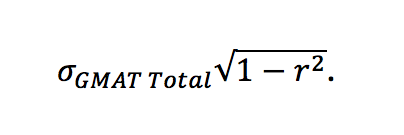GRE to GMAT Conversion: Why You Can’t Compare Scores

If you’re applying to business school, you’re very likely to sit an admission test. The GMAT is the world’s most popular business school test, taken by 7 in 10 business school applicants.
For decades, the world’s top business schools’ admissions teams have trusted the GMAT as it is the only test that has been specifically created to predict performance in the MBA.
In November 2023: the updated and streamlined GMAT Focus Edition was launched. Around the same time, a shortened version of the more general graduate test, the GRE, also became available.
Both GMAT Focus Edition and GRE are accepted by many business schools. However, it’s important to know that the score you achieve if you sit the GRE cannot be converted to a GMAT Focus Edition score, and vice versa.
In this article, we will show you why you cannot compare a GMAT Focus Edition score with a GRE score.
Additionally, we will explain why the conversion tools you’ll find online are very inaccurate and will not help your business school preparation.
GRE to GMAT conversion: Can you convert your GRE score to a GMAT score?
Bottom line: you can’t convert a GRE score to a GMAT Focus Edition score, and vice versa. The GRE and GMAT Focus Edition exams are different tests, measuring different content, and no conversion table or conversion tool can ever make them equivalent. The best way to know what your GMAT Focus Edition score would be is to prepare for and take the exam.
Is the content of the two exams really that different? Yes, it is.
The GMAT Focus Edition is the only admissions test designed specifically to be used for admission to graduate business programs. It measures the higher order skills most relevant to succeed in a graduate business program. Its three sections target specific skills that are highly relevant to the business career path you aspire to.
The GRE, on the other hand, is (by design and name) a general test and its three test sections are not related to any specific field of study.
When you complete the GMAT Focus Edition, the Total Score you receive is computed by combining the scores from the exam’s three sections: Data Insights, Verbal Reasoning, and Quantitative Reasoning. However, conversion tools you’ll find online do not provide any data points for the Data Insights section.
The problems with the GRE Comparison Tool for Business Schools and other GMAT conversion tables
For more than a decade, Educational Testing Service (ETS), the company behind the GRE General Test, hosted on its website—and promoted to business schools—a tool that it claimed could predict GMAT scores based on GRE scores. Although this tool no longer sits on the ETS website, a number of other websites have duplicated the conversion chart.
There are several critical flaws in the research design and interpretation that ultimately make this tool inaccurate and unhelpful to both test takers (and business schools).
In short, the creators of the GMAT Focus Edition would strongly advise against using the tool to support your test prep or self-assessment.
If you wish to know the detail as to why the tool is inaccurate, then please read on.
Data-related issues with the Comparison Tool
The GRE conversion tool was built using a small sample of test-takers from 12 years ago—long before both the GMAT and GRE exams were updated—and therefore is completely out-of-date. Additionally, the data sample taken to create the tool was small nd unrepresentative of all test-takers. It was also built on self-reported data which is inherently inaccurate.
Methodological and procedural issues
The GRE conversion tool uses three linear regression models for predicting GMAT Total, GMAT Quant, and GMAT Verbal scores, and claims “the predicted score range is approximately +/- 50 points for the Total GMAT score and +/- 6 points on the Verbal and Quantitative scores”.
The uses of linear regression models resulted in systematic prediction errors (i.e., score bias) and the difference in measurement errors between GRE and GMAT was completely overlooked when the tool was built.
Correlation does not guarantee linearity
Given the substantially different score distribution shapes between GRE Quant scores (which is close to a normal, bell shape curve) and GMAT Quant scores (which is very negatively skewed) even if the rank order of GRE scores were perfectly preserved in GMAT scores—which is not true at all—their relationship is expected to be non-linear especially for the top scorers. As a consequence, the estimated prediction models are expected to introduce substantial prediction bias, especially toward the top end of the score range.
Fundamental differences in test design were ignored
GRE’s conditional standard error of measurement (CSEM) across score areas is expected to be significantly different from GMAT’s due to difference in the test design—Multistage Testing (MST) for GRE vs. Computerized Adaptive Testing (CAT) for GMAT. With GMAT’s CAT algorithm, which very tightly controls the CSEM across all reported score range, the CSEM for GMAT Total is consistently around 30~40 even in the higher score area (>700). GRE, however, with just two stages in its MST design (i.e., it is only 50% adaptive at best), substantial fluctuations in CSEM is expected, especially in the higher score area.
The prediction interval is an underestimation of the truth

Computing SE of prediction using this equation, however, is appropriate only when several key assumptions are met, such as linearity, independent errors, a normal distribution of errors, and equal error variances. Given all problems already described, it’s evident that all of the critical assumptions for this equation were violated.
On top of this, the tool also ignored the CSEM of GRE scores in the prediction error computation as if the GRE were error-free measure. In fact, GRE scores are likely to have relatively larger CSEM, especially at the higher score range and, as a result, the predicted GMAT Total score is not at all useful for critical decision making (if the prediction is not already completely meaningless due to all the data and model related issues pointed out so far) with the empirical SE of prediction that could be 2~3 times larger than ETS estimated.
In creating the conversion tool, ETS did not use its own “predicted GMAT Q and V scores” for predicting GMAT Total scores but introduced another different multiple regression model.
On ETS’s website, the company stated as a footnote, that “the predicted score range is approximately +/- 50 points for the total GMAT score…”
The “prediction interval” should always be presented with its confidence level, such as 68 percent (=1SE), 95 percent (=2SE), or 99 percent (=3SE) confidence level. Their statement is deceiving the public as if they were reporting 100 percent confidence (“predicted score range” means the difference between the minimum possible predicted score and the maximum possible predicted score) while their reported values were actually only for 68 percent confidence interval.
Also, the SE that ETS computed was 54.8, and it was rounded down to 50.More importantly, given the serious underestimation of the prediction SE, the actual SE is expected to be much larger than “50 points” when it appropriately accounts for GRE’s SEM as well as predictor’s relative location to its mean.
For example, in the GMAT Total score area like 650 or above, which is what many schools are interested in, there is no evidence that the actual prediction error with 99% confidence interval to be any smaller than ± 200 points. It means that the true GMAT scores for individual candidates whose predicted GMAT Total scores were 650 could be anywhere between 450 and 800, 99 percent of time, if not worse, even in the best-case scenario where ETS’s regression model somehow did not cause any prediction biases despite the data-related issues pointed out above.
Why take the GMAT Focus Edition exam? It’s purpose-built for business school
Since 1953, the GMAT exam has been the only admissions test designed specifically to be used for admissions to graduate business programs. And because the GMAT Focus Edition is designed specifically for business, the time you devote to prep is an investment not only earning your best score, but also in sharpening your skills for business school and your career. The world’s leading business schools trust the GMAT Focus Edition exam because it’s specifically validated to predict performance in the first year of an MBA program, and your GMAT Focus Edition score signals to them that you’re serious about pursuing a graduate business degree from their school.
If getting into your top choice business school is your goal, earning your best GMAT Focus Edition score is one of the best ways to demonstrate that you’d make for an excellent addition to their next incoming class.

